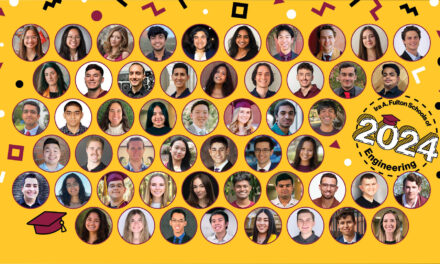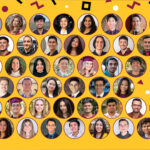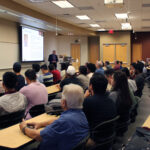
ASU leads effort to bring sustainable water and enterprise to the Middle East

Above: The Microgrid Test Bed at Arizona State University’s Polytechnic campus will help the ASU-led international consortium team develop and test an energy system to support solar-powered water purification systems for communities in Jordan and Lebanon. Photo courtesy of Nathan Johnson/ASU
Clean water — and having enough of it — is a worldwide problem. For residents in Lebanon and Jordan, a lack of clean, drinkable water is the most pressing resource problem as the region faces severe water shortages. For refugees living in informal encampments or urban host communities, it’s an even bigger problem.
To compound the issue, the electrical grid is often unreliable or nonexistent in communities that lack clean water access — meaning water purification is unreliable, expensive or out of reach for local populations.
Arizona State University is leading an international consortium in a $1.95 million, two-year U.S. Agency for International Development project to research and develop affordable, portable clean water solutions and business for the Middle East.
ASU brings expertise in engineering, sustainability and law to the project, “A Holistic Water Solution for Underserved and Refugee Host Communities in Lebanon and Jordan,” sponsored by the USAID Middle East Water Security Initiative.
The university’s Ira A. Fulton Schools of Engineering, Walton Sustainability Solutions Initiatives and Sandra Day O’Connor College of Law collaborate with U.S. and international partners, which include Lebanese non-governmental organization René Moawad Foundation, global non-governmental organization Mercy Corps, social enterprise H2O for Humanity and development tech firms Zero Mass Water and GreenCo Water.
Together, they will implement clean water systems that will benefit approximately 36,000 people.
Leveraging non-traditional water resources
The region’s surface water is rapidly depleting, and groundwater collected from wells is high in salts and contaminants as a result of poor sewage systems and waste disposal as well as unregulated industrial waste.
Another source often overlooked — water vapor — is always present, regardless of humidity, but it’s not easily harvested.
The team is working to make these two water sources viable for their communities.

Hasan Daouk of Zero Mass Water and ASU Professor Rhett Larson (right) discuss placement of H2O for Humanity’s AquaSafi-2000 water purification system in the existing kiosk at an out-of-use well in Qubbe, Lebanon. Photo courtesy of Ashley St. Thomas/ASU Walton Sustainability Solutions Initiatives
Each community served by the project has a larger purification system, H2O for Humanity’s low-cost, low-energy AquaSafi 2000 reverse osmosis water purification system kiosk, which desalinates groundwater and eliminates contaminants including bacteria and excess fluoride. Remote monitoring technology allows for efficient scaling, lower operational costs and quality control.
At the household level, Zero Mass Water’s SOURCE solar-powered system captures atmospheric water vapor and converts it to drinking water. The system is portable, making it suitable for permanent residences and refugee settlements alike, and allow families to truly own their water supply.
Both technologies make use of GreenCo Water’s Pak-Flat Tank, a 1,000-liter tank that is packaged flat and can be assembled in less than 10 minutes. Adding this storage method will increase available water sources by 20 percent in these communities.
Engineering a power source
From the Polytechnic School, one of the six Fulton Schools, Assistant Professor Nathan Johnson leads the effort to design, integrate and deliver an advanced power system for the project. Johnson has extensive experience in the research and development of sustainable energy methods and technologies. His team will also work closely with H2O for Humanity to complete a full system redesign of the integrated water-energy system, fabricate and test those systems at ASU and implement and monitor the prototypes during field testing in Jordan and Lebanon.
“Many grid-connected solar energy systems shut off when the grid goes down,” Johnson explains. “This is a protection mechanism that prohibits solar photovoltaic systems from exporting power back to the grid, and thereby creating the risk of shock to any workers fixing the electrical grid.”
The local electric grids in the project area can experience outages for hours at a time. Johnson’s team is working to create a way to keep the water pumps and reverse osmosis filtration running safely and reliably despite power outages and fluctuations in power quality.
“The Universal Power System designed for this work will include switchgear and microgrid capabilities to permit the utilization of solar PV whether or not the grid is available,” Johnson says.
Johnson’s team aims to create a system that reduces energy costs by 25 to 50 percent and increases energy efficiency by 15 to 30 percent over the current AquaSafi 2000. This will also include solar PV integration and two days of autonomy in case of total power loss and to “complete a full system redesign of the water reverse osmosis system in conjunction with the energy system to achieve multiplicative energy and cost savings,” Johnson says.
A prototype of the system will be developed at ASU’s Polytechnic campus before its implementation in Jordan and Lebanon. Johnson thinks this is one of the benefits to ASU’s involvement in the project.
“We have a similar climate to Jordan and Lebanon in which to prototype and test the engineered system,” Johnson says. “We also have access to a one-acre microgrid test bed that includes electrical equipment to ‘run our prototype through the gauntlet’ for testing system performance, durability and reliability.”
Tailoring a sustainable system for the region
Johnson says design requirements are a big challenge with ensuring the success of an international design project. Without accurate or complete design requirements, engineers will often resort to speculation or assumptions and end up missing their goals.
“Our team at ASU follows a rigorous approach of human-centered design that uses participatory research, focus groups, deep interviews, surveys and field visits to obtain information that informs the design requirements,” Johnson says. “These design requirements are reviewed by those in the project who have background and knowledge of cultures in the end communities and in our culture to help us understand the intent or judgments behind the actions or choices that we can more easily observe.”
It can be difficult to manage and implement a project from the other side of the globe, says Richard Rushforth, an assistant research professor at Northern Arizona University, who was previously a water policy researcher and project manager with ASU’s Walton Sustainability Solutions Initiatives until January 2017.
Together with International Project Manager Ashley St. Thomas, who is also a proposal manager at ASU’s Walton Sustainability Solutions Initiatives, Rushforth helped the team to develop a cohesive project that comprehensively addresses the interconnected challenges affecting water security in Lebanon and Jordan while building partnerships to maximize the benefit to the communities served.
“We have expanded our core team to include a dedicated project coordinator based in Amman, Jordan, to act as our eyes and ears on the ground and to troubleshoot any logistical problems that may arise,” Rushforth says. “We are continuously working to improve our communication channels between our partners at ASU and with our partners in the field and around the world.”
These partnerships are vital to ensure there are robust local supply chains to keep up with providing the tools, supplies and materials needed for maintenance in addition to local people who will sustain operations.
René Moawad Foundation and Mercy Corps, who are the project’s implementing partners in Lebanon and Jordan, respectively, will collaborate with local women’s cooperatives to train women entrepreneurs to manage water kiosks and generate income. These partners will also raise awareness of water-demand management in the communities.

Local utility experts discuss the water quality details with ASU professor Rhett Larson (at right) for a well under consideration in Qubbe, Lebanon. This site is being considered as the first for implementation and would provide purified water to people in Bab El Tebbeneh, one of the poorest communities in Lebanon. Photo courtesy of Ashley St. Thomas/ASU Walton Sustainability Solutions Initiatives
Ties to local and national water authorities and other organizations also strengthen the project’s ability to help people in the region access water in a sustainable way.
Professor Rhett Larson, an expert in Middle East water policy with the ASU Sandra Day O’Connor College of Law, helps to ensure the team’s efforts conform to local laws and customs regarding water rights and pricing.
He emphasizes the benefit of the ASU team’s interdisciplinary nature in a project involving something as complex as water.
“You cannot develop water without considering environmental, technical, economic, cultural and legal issues,” Larson said in a press release. “Our team is made up of experts in all areas of water policy and management, which makes this project especially exciting. We have a chance to truly help thousands of people in need.”
Rushforth agrees that ASU’s strengths in this area helped it secure this project and aids in what the team can accomplish.
“ASU’s strength and focus on developing a transdisciplinary culture that encourages professors and students to work together across traditional disciplinary boundaries to solve the world’s biggest challenges enabled us to win this project and will ensure its success in the future,” Rushforth says.
He and the team will use experience from other successful projects in similar regions and implementations — from agribusiness in Egypt to sustainability education in Nigeria to sustainable energy systems in Albania — to achieve their goal to increase the water security of vulnerable people and refugee host communities in Lebanon and Jordan.
“Our priority is to maximize the number of beneficiaries reached with reliable, low-cost drinking water — all while providing economic opportunities in the process,” Rushforth says.



































